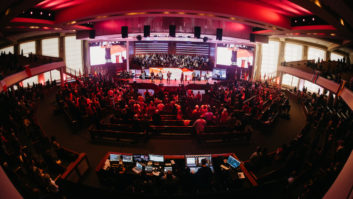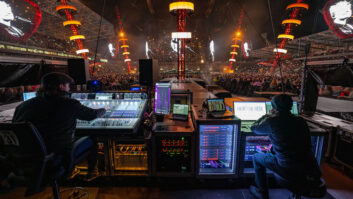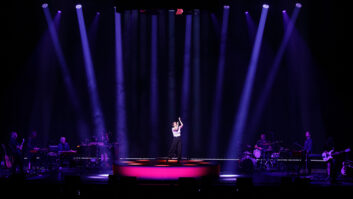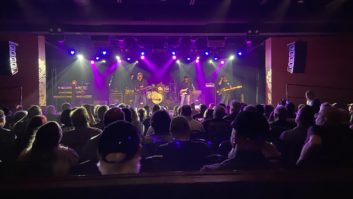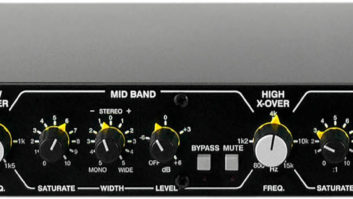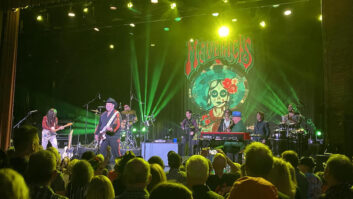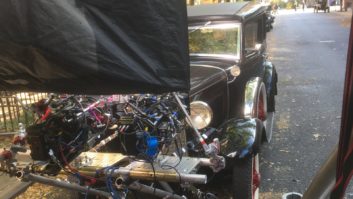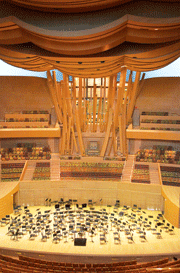

Walt Disney Concert Hall with the sound system removed for a symphonic performance
Large symphony halls are carefully designed to enhance the sound of acoustic instruments. Normally, they feature reflective surfaces that help the audience and performers hear more clearly the balance of classical orchestras, string quartets, choirs and similar ensembles. But when the same reverberant hall is used for performances that involve amplified instruments and a P.A., things soon become a shade more complicated.
It’s a situation that Fred Vogler faces on a daily basis. As sound designer and lead mixer at the world-famous Hollywood Bowl, Vogler also works with the Los Angeles Philharmonic in its winter home, the new Walt Disney Concert Hall, located within the Frank Gehry — designed building in downtown L.A. “While the Hollywood Bowl is a unique environment,” Vogler concedes, “it is at Walt Disney Concert Hall that I face some of my biggest challenges.”
The 293,000-square-foot Walt Disney Concert Hall (WDCH) and companion buildings encompass two outdoor amphitheaters and space for pre-concert events. The centerpiece of the complex is a 2,265-seat concert hall in which the L.A. Philharmonic presents more than 150 concerts a year. The interior was designed to retain the acoustical characteristics and intimacy of traditional “shoebox”-style concert halls while allowing more flexibility in architectural design. Audience members surround the orchestra platform; a pipe organ occupies a central position between the seating sections at the rear of the stage.

L-R: Bruce Leek, ATC consultant; Ben Lilly, ATC Transducer/R&D
engineer; Fred Vogler, WDCH sound designer; and Bob Polley,
ATC operations director
“As a sound designer,” Vogler says, “I need to find a balance between sound level and sonic fidelity. After all, even the most classically minded purists like amplified music. It’s challenging to make sure that sound systems work with, rather than against, the acoustical environment in which they are located. Here at Walt Disney Concert Hall, we now have a state-of-the-art sound system that is excellently balanced for this environment.”
CONTROLLING REVERB
Given its primary use for classical music performance, WDCH features a reasonably live reverberant field within what is considered one of the best-sounding symphony halls in the world, thanks in no small part to the outstanding work of acoustician Dr. Yasuhisa Toyota from the Tokyo-based Nagata Acoustics. “Toyota-san ensured that the RT60 is remarkably consistent at all frequencies,” Vogler says, “but it is that reverberant field that can muddy up amplified sound and announcements. When we have a mixture of acoustic energy and amplified instruments onstage, ensuring a natural balance between the two sources can be problematic, even for the most experienced sound mixers.”
Determining the ways in which proper sound reinforcement should be provided at WDCH falls to a sound council that regularly meets to discuss progress with the hall’s various acoustic and electroacoustic systems. The committee comprises Gail Samuel and Paul Geller from the philharmonic; Kevin Wapner, the hall’s head of audio/video; and Vogler, independent consultant/sound designer. Because WDCH offers an eclectic mix of symphonic and leased events, the hall’s sound system needs to be fully removable.
“We have focused on controlling reverb time,” Vogler states. “We’ve added a series of motorized curtains in all four corners of the hall.” A quartet of 40-foot-tall, white acoustic curtains per corner can be set to overlap one another or extend to their full width, covering approximately 60 feet. “We have also added pipe and drape with absorbent material close to the onstage sound sources,” the designer continues. “These materials prevent first reflections off the wooden surfaces adjacent to the stage from building up in energy and becoming difficult to absorb elsewhere in the hall.”

The stage-right cabinet includes a movable, forward-facing HF/MF element that houses a pair of HF tweeters, two midrange drivers and a third HF tweeter. The upper two HF and one MF driver comprise a long-throw combination for the distance audience sections, while the lower MF and single HF driver cover close audience areas.
A major revision this season has been a central cluster with left/center/right and rear-firing elements that was derived from last year’s left/right JBL VerTec line array. “We felt that the original stereo line array posed problems,” Vogler recalls. “The speakers were suspended high above the stage and about 20 feet off-center. As a result, the acoustic center of the soundfield did not match the location of onstage performers; audience members were distracted because the sound was coming from a different position. Since the concert hall environment has such a clear and present sound, directivity is critical.”
The new center cluster was designed by Patrick Baltzell from Baltzell Design Associates, with modifications by independent consultant Don Pearson and Ted Leamy, JBL Professional’s director of engineered sound marketing. “The new center array is an organic evolution that marries the acoustical image with amplified sound,” Leamy explains. “This system is being used for true sound reinforcement of voices and certain instrumentation in an already spectacular acoustic environment.”
The cluster is suspended 28 feet above the stage close to the downstage edge in a central location, and comprises 11 forward-facing VerTec VT4887 cabinets and trios of six 4887s facing stage-left/right/rear, all powered by Crown MA Series amplifiers. Custom-designed ATM FlyWare swivel suspension was also specified.
ON THE STAGE, LEFT AND RIGHT
If the central cluster design represents a bold move, even more adventurous was the evolution of a new stage-mounted left and right array. After a recommendation from Dr. Toyota that the loudspeaker system be stage-mounted, Vogler consulted with longtime friend Billy Woodman, owner/chief engineer of ATC Loudspeaker Technology in England. “I’ve been using ATC studio monitors for a number of years,” Vogler states, “and, with Billy’s guidance, had experimented last season with an array of six SCM150A cabinets: two per side facing forward into the audience and one per side tilted to serve the upper-side audience members. Due to the success of this experiment, we asked Billy to develop a custom design for the Walt Disney Concert Hall.”

The JBL VerTec center cluster is suspended 28 feet above the stage, close to the downstage edge in a central location.
Woodman’s team of engineers, including Bob Polley, ATC operations director, and Ben Lilly, acoustic design engineer, set out to create a system that would work with the natural acoustics of the hall, the performers and the audience. As Woodman states, “The hall is designed around the acoustic source being located on the stage; therefore, it [is] essential to have the electroacoustic source on the stage, as well.” During tests, the design team found that the concert hall offered an extremely flat magnitude response and even reverb time for all frequencies. “Using our soft-dome midrange transducers, wide lateral dispersion is maintained across the frequency band,” Woodman adds.
The resultant arrays stand 7.5 feet tall and weigh some 1,000 pounds each. Both left/right systems comprise a large low-frequency cabinet containing eight 15-inch transducers, on top of which is mounted an adjustable assembly supporting the three MF/HF elements. The single front-facing MF/HF cabinet houses — from top to bottom — a pair of HF drivers, two midrange drivers and a single HF unit. The upper two HF and one MF driver comprise a long-throw combination for the distant audience sections, while the lower MF and single HF driver cover close audience areas. The shorter side and rear-facing MF/HF cabinets each house single HF and MF drivers.
The new cabinets are finished in the same light-colored Douglas fir as the organ pipes located in the rear of the stage, with grille cloths that complement the fabric used for the seat coverings. “ATC took its aesthetic inspiration from the design of the hall’s organ pipes with great success,” Vogler says. “Our major question now, in terms of maintaining the acoustic center of the soundfield to match the onstage visual focus, is how much of the central cluster is needed?”
Mixing at WDCH is handled with a 96-channel Yamaha PM1D digital assignable console; a second PM1D is available for onstage monitoring. For added flexibility, the PM1D’s control surface can be moved out of the control room into an acoustically treated audience area directly in front of the mixing booth. For added control, dedicated stem-mix outputs from the front-of-house console connect to the front/side and rear-facing cabinets within the onstage array, with the front-facing long and medium-throw components being driven with an approximately 4dB gain offset. A submix feeds the central array.
“I often compare sound systems at the Hollywood Bowl and Walt Disney Concert Hall in terms of an analogy with race car technologies,” says Vogler. “If the Hollywood Bowl is like NASCAR — brute force and power, but outstanding excitement and long-distance performance — the WDCH is like Formula One: constant acceleration or deceleration with many straightaways and curves. One mistake and you can be very surprised at the results!”
Mel Lambert (www.mel-lambert.com) heads up Media&Marketing, a full-service consulting service for pro audio firms and facilities.

All photos by Mel Lambert/content-creators.com


The shorter, side- and rear-
facing MF/HF cabinets each house single HF and MF
drivers.
Bob Polley, ATC Operations Director, checking orientation of movable HF and MF elements


Performances by a specially invited jazz ensemble-The Brad Miller Band-enabled WDCH’s sound crew to evaluate a
number of loudspeaker
locations and develop trial
mix levels.
During band set up, various positions/orientations were tried for the left
and right ATC arrays.
XXX
XXX
XXX

